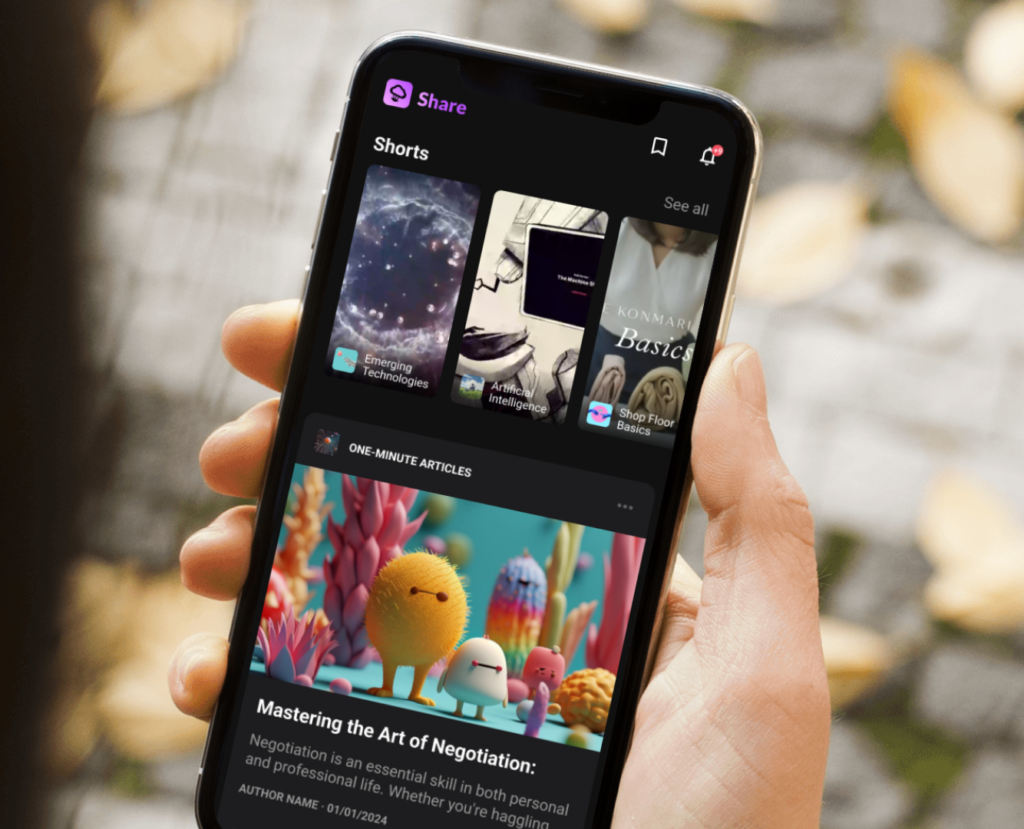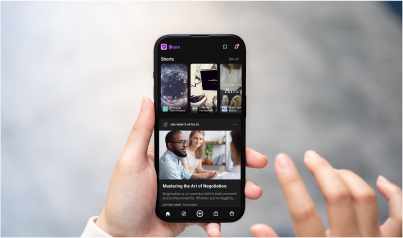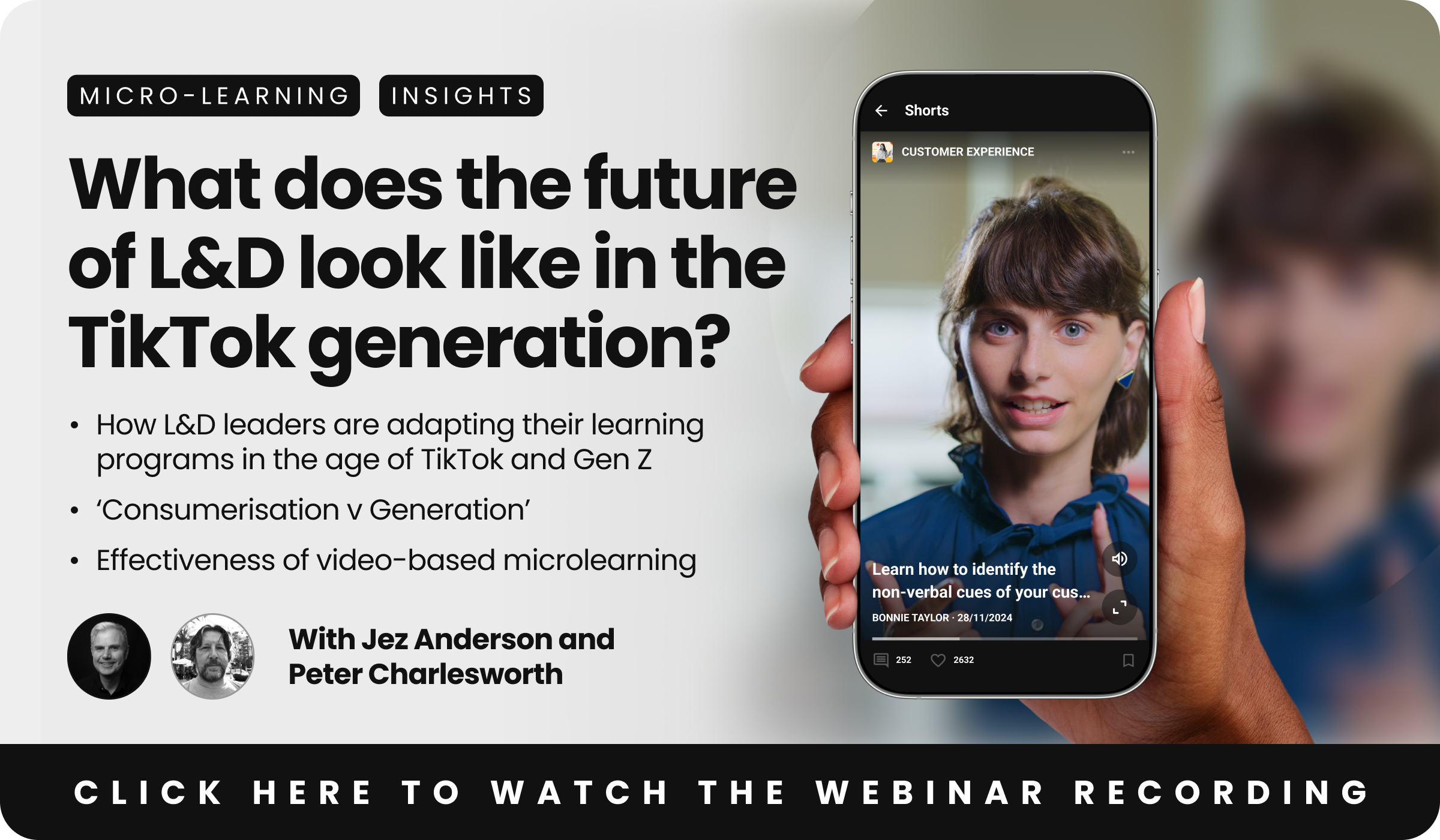In a digital world where attention spans are shorter than ever, the rise of video learning has transcended a modernised approach to learning and development. The introduction of younger ‘Gen Z’ employees across organisations in recent years has seen a sea change in how learning is delivered. Younger learners expect accessible information that is engaging, digestible and informative. Video-based microlearning leverages TikTok-style shortform content that resonates with a younger audience who have grown up in the age of social media, YouTube and TikTok.
In this article, we explore the concept of video learning and how L&D methods are shifting to accommodate a younger workforce. You’ll discover the differences between video learning and microlearning videos, uncover the nuances of Gen Z learning styles and find out how interactive eLearning experiences are elevating L&D.

An overview of video learning
Video-based learning is an interactive learning method that comprises animations, graphics, film, text and audio. This combination of various engaging components creates an elevated multi-sensory experience for learners to increase engagement. Traditionally, video learning has taken the form of lectures, webinars, narrated presentations with quizzes, but as the influence of social media has heightened in recent years, video learning styles in the L&D industry have evolved. However, the key benefits of adopting video learning as part of your L&D program remain.
The benefits of video-based learning
Video learning methods offer a lighter alternative to text-based learning modules. Being able to understand new concepts is fundamental to the successful implementation of a learning program. Providing learners with adequate tools to absorb information for continuous development can take many forms. Here’s what video-based learning can offer your learners.

Captivating and concise
Communicating new ideas in a succinct manner provides learners with the ability to easily absorb new information. Video learning provides a lighter delivery style of imagery, audio and text that can engage and inform.
Adaptable and accessible
The consensus that younger workers are more inclined to appreciate video learning than older generations. However, video-based learning cuts across the generational divide by presenting information that supports different learning styles. Functionalities such as transcripts, captions and subtitles can be added to enhance accessibility for all users.
Reduced cognitive load
Large blocks of text can be overwhelming and disruptive for learners when trying to engage with learning. A cluttered visual layout overloaded with text can increase the cognitive load of a learner which isn’t conducive to knowledge retention. A good user interface should incorporate striking visuals with audio and concise text blocks to reduce cognitive load and maximise stickiness for learners.
Gen Z and Microlearning: How L&D is evolving
In recent years, TikTok has become the de facto symbol of Gen Z culture. The rise of influencers and an emergence of viral trends synonymised by image are central to the perception of Gen Z. When assessing this from an L&D standpoint, growing up in the digital age with immersive technologies at their fingertips, connecting with younger workers requires an innovative approach to learning. In theory, this means learning styles that may have once worked for your employees need refreshing to accommodate for the changing L&D landscape.
The stratospheric rise of TikTok can be cited as the inspiration behind the subsequent increase in microlearning videos which have permeated the L&D industry. The introduction of younger, tech-savvy workers into the workplace has seen new learning methods emerge. Although it is easy to dismiss social media platforms like YouTube and TikTok, L&D professionals have recognised that these platforms are a valuable learning tool for many Gen Zers and can also offer many benefits for employees that fall outside of the Gen Z scope.

Gen Z workplace attitudes
There is a common misconception that Generation Z’s workplace attitudes differ to generations of yesteryear. It’s not uncommon for younger workers to be labelled negatively for their perceived lack of application towards work. However, the statistics displace this notion, Deloitte’s 2024 Gen Z and Millennial Survey illustrates that 86% of Gen Z’s surveyed said that the “having a sense of purpose is very or somewhat important to overall job satisfaction and general wellbeing”.
The McKinsey Quarterly report on Gen Z attitudes towards work further cements the notion that Generation Z prioritise career development over financial gain. Their report notes that Gen Z workers could potentially make up a quarter of the global workforce by 2025 with career development. Therefore, seizing the initiative is imperative to develop learning styles that align with the appetite that younger workers are showing for developing early in their careers.
Using microlearning videos to cater to Gen Z learning styles
Microlearning videos are analogous to TikTok-style content helping to engage and capture younger learners with fleeting attention spans. The concept of video-based microlearning is centred on short, dynamic content that corroborates with TikTok and Instagram reels, naturally progressing from the longer styles of traditional video learning modules.
Shorter videos cater to the preferred Gen Z learning style of multi-sensory learning experiences. Equally, the flexibility microlearning videos offer to learners provides older employees with tangible benefits that can be helpful for development, motivation and engagement.
Other benefits of microlearning videos include:
Empowered learning
Learning should instil a sense of pride, achievement and motivation. Microlearning videos enable this by empowering learners to discover new topics with a self-directed learning approach to align with the goals of individuals. Although the interactive features may resonate more with a younger audience, this can be useful for older employees looking to make the next step in their career by upskilling.
Customisable features
Personalising learning paths provide users autonomy as they learn. Microlearning videos contain functionality for customisation based on relevancy. This enables learners to feel their way into unfamiliar topics or longer training modules at their own pace by pausing, rewinding or watching as learners desire to absorb the information properly.
Knowledge retention
As discussed in the previous section, learning through video offers an easier format for remembering vital information. Microlearning videos build upon these this same principle which is known as the ‘spacing effect’. This concept derives from neuroscience research which reinforces the idea that learning is effective when divided into sections. Video microlearning is a great foundation for refresher training to build learners’ familiarity for topics they need to recall quickly.

Progression and development
Video microlearning encourages continuous development in the workplace. Learning that is segmented into small, manageable modules instils confidence in learners. Plus, if your training methods training gains traction for being progressive, this will only help further your ability to retain top talent and enhance your business’ reputation as a company that invests in staff.
Agile, scalable and practical
Videos can be easily adapted to align with compliance changes without the need for complete rewrites of course content. Whilst learners reap the rewards of up-to-date training, organisations can too – through the form of an upskilled workforce that can help the business expand. If you’re a large-scale organisation, then the ability to scale training across different departments and regions adequately without added cost is also a huge incentive.
Embrace the art of microlearning with Netex
Here at Netex, we can incorporate video-based learning to transform L&D for your employees. We’ve helped global brands like Haagen-Dazs, developing an innovative gamified video with personalised branding to empower and upskill learners through microlearning.
Our learning management system is an e-learning ecosystem that provides an innovative and immersive user experience, with a range of innovative learning tools that can transform eLearning across your organisation. Use our content authoring tool to create, edit and tailor training easily, or explore our social learning platform to build bespoke content libraries suited to the needs of your employees. We also create tailored training programs through our bespoke content studio personalised to your brand.
For an in-depth discussion about our products, why not contact us today to discuss your options further or to book a demo to see our learning solutions in action.